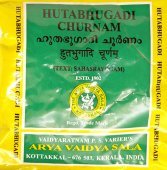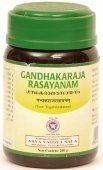Pathya, Pathyā, Pāṭhya: 30 definitions
Introduction:
Pathya means something in Hinduism, Sanskrit, Marathi, Hindi, biology. If you want to know the exact meaning, history, etymology or English translation of this term then check out the descriptions on this page. Add your comment or reference to a book if you want to contribute to this summary article.
Pathya has 29 English definitions available.
Alternative spellings of this word include Pathy.
Languages of India and abroad
Sanskrit dictionary
[Deutsch Wörterbuch]
Source: Cologne Digital Sanskrit Dictionaries: Böhtlingk and Roth Grosses Petersburger WörterbuchPathya (पथ्य):—
--- OR ---
Pāṭhya (पाठ्य):—(vom. caus. von paṭh) adj. der des Unterrichts bedarf [Bhāgavatapurāṇa 7, 5, 2.]
--- OR ---
Pāthya (पाथ्य):—ved. adj. von pāthas (= pāthasi bhavaḥ) [Pāṇini’s acht Bücher 4, 4, 111.] vṛṣā [Ṛgveda 6, 16, 15.] patron. nach [Sāyaṇa], anders [Mahīdhara] zu [Vājasaneyisaṃhitā 11, 34.]
--- OR ---
Pathya (पथ्य):—
1) a) [Sp. 423, Z. 6. fg.] streiche die Stelle [Rāmāyaṇa 2, 68, 10] u. s. pathyaśana . — b) so v. a. herkömmlich, regelmässig [Weber’s Indische Studien 8, 84. 102. 104. 107.] —
2) b) [Bhāgavatapurāṇa 12, 7, 1.] —
3) d) Nomen proprium eines Frauenzimmers [Kathāsaritsāgara 73, 417.]
--- OR ---
Pāṭhya (पाठ्य):—zu recitiren: jagrāha pāṭhyamṛgvedātsāmabhyo gītameva ca [Oxforder Handschriften 265,b,24.] [Rāmāyaṇa.7,94,2.] [Sāhityadarpana 542.]
Source: Cologne Digital Sanskrit Dictionaries: Sanskrit-Wörterbuch in kürzerer FassungPathya (पथ्य):——
1) Adj. — a) herkömmlich , regelmässig. — b) angemessen. — c) förderlich , zuträglich , heilsam (am und übertr.). —
2) m. — a) *Terminalia Chebula oder citrina. — b) Nomen proprium eines Lehrers. —
3) f. pathyā , pathiā — a) Pfad , Weg revatī und svasti personif. als Genie der Fülle , des Wohlstandes , der Wohlfahrt — b) Terminalia Chebula oder citrina. — c) *eine Gurkenart. = cirbhiṭā und [Rājan 7208.211.] — d) * = vandhyākarkoṭakī [Rājan 3,49.] — e) N. verschiedener Metra. —
4) *n. eine Art Salz [Rājan 6,90.]
--- OR ---
Pāṭhya (पाठ्य):—Adj. —
1) zu recitiren. —
2) der des Unterrichts bedarf.
--- OR ---
Pāthya (पाथ्य):—pāthia nach [Sāyaṇa. ] m. Patron. , nach [Mahīdhara] Adj. = sanmārgavartin oder hṛdayākāśe bhavaḥ Vgl. pānthya.
Sanskrit, also spelled संस्कृतम् (saṃskṛtam), is an ancient language of India commonly seen as the grandmother of the Indo-European language family (even English!). Closely allied with Prakrit and Pali, Sanskrit is more exhaustive in both grammar and terms and has the most extensive collection of literature in the world, greatly surpassing its sister-languages Greek and Latin.
See also (Relevant definitions)
Starts with (+15): Pathya-samagri, Pathyadana, Pathyadena, Pathyakara, Pathyakari, Pathyakrama, Pathyala, Pathyamana, Pathyamritadi, Pathyamsha, Pathyamsha-cakra, Pathyapani, Pathyapathya, Pathyapathya dhanvantariya, Pathyapathyadhikara, Pathyapathyanighantu, Pathyapathyanirnaya, Pathyapathyavibodha, Pathyapathyavibodhaka, Pathyapathyavibodhanighantu.
Ends with (+11): Anupathya, Apathya, Asampathya, Asinapathya, Avapathya, Baddhanepathya, Balapathya, Brihatpathya, Dhanvantariya pathyapathya, Dhanvantariyapathyapathya, Hitapathya, Kupathya, Mathapatya, Naipathya, Nepathya, Nitpathya, Parinamapathya, Paripakapathya, Paripathya, Pathyapathya.
Full-text (+78): Paccha, Apathya, Pathyapathya, Parinamapathya, Prapathya, Pathya-samagri, Pathyashin, Sthitapathya, Kumudadi, Kupathya, Nepathya, Viparitapathya, Hitapathya, Supathya, Pathyaratnakosha, Pathyapathyavinishcaya, Pathnya, Apathyabhuj, Apathyanimitta, Vyadhita.
Relevant text
Search found 46 books and stories containing Pathya, Pathyā, Pāṭhya, Pāthya, Paṭhya, Paathya; (plurals include: Pathyas, Pathyās, Pāṭhyas, Pāthyas, Paṭhyas, Paathyas). You can also click to the full overview containing English textual excerpts. Below are direct links for the most relevant articles:
Rig Veda (translation and commentary) (by H. H. Wilson)
Dramaturgy in the Venisamhara (by Debi Prasad Namasudra)
The Usage of Language in a Drama < [Chapter 4 - Dramaturgy in Veṇīsaṃhāra]
Vṛttas (syllabic metres) < [Chapter 4 - Dramaturgy in Veṇīsaṃhāra]
Bhakti-rasamrta-sindhu (by Śrīla Rūpa Gosvāmī)
Verse 2.1.156 < [Part 1 - Ecstatic Excitants (vibhāva)]
Vedic influence on the Sun-worship in the Puranas (by Goswami Mitali)
Part 19 - Pūṣan (the Knower of the Paths) < [Chapter 2 - Salient Traits of the Solar Divinities in the Veda]
Mudrarakshasa (literary study) (by Antara Chakravarty)
2.19. Use of Gīti metre < [Chapter 4 - Employment of Chandas in Mudrārākṣasa]
4. The entity of Vṛtti and its use in Mudrārākṣasa < [Chapter 5 - Adoption of Style and Language in Mudrārākṣasa]
5. Pravṛtti (traditions according to time and place) < [Chapter 5 - Adoption of Style and Language in Mudrārākṣasa]
The Agni Purana (by N. Gangadharan)
Related products
(+19 more products available)





